Teaching math using interactive white boards
By Murray Bourne, 21 Sep 2009
Several readers have written asking me to write an article about teaching math using an interactive white board.
You may have seen interactive white boards on TV during the election campaigns. The reporters could zoom in on particular areas in the USA map and bring up statistics on how the parties were faring.
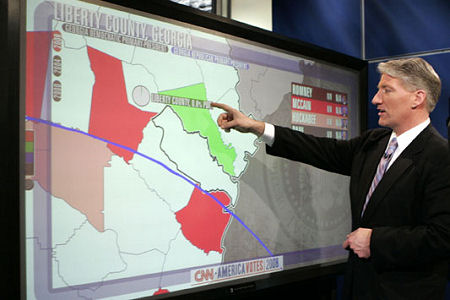
A CNN reporter using an interactive whiteboard. [Image source: NYTimes]
These interactive whiteboards are rapidly becoming popular in classrooms around the world.
I recently conducted an email interview with math teacher Jacky Gruszka on her use of the interactive white board. Jacky is an enthusiast for such interactive boards and has reported that she's become much more excited about teaching math since she began using them.
The particular interactive whiteboad that Jacky uses is the SMARTBoardTM. This board allows her (and her students) to interact with objects (graphs, diagrams, Flash and java applets, etc) that are projected from her computer via an attachment that sits above the screen.
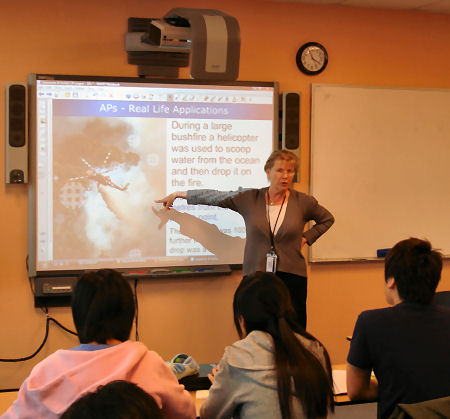
Jacky Gruszka in action with the SMARTBoard.
Note the projector above the board.
Jacky writes:
Dear Murray
Thanks for giving me the opportunity to talk about my use of the interactive whiteboard, specifically the SMARTboard, which I began using in February 2009. Using the SMARTboard has been an engrossing, new and exciting experience for me.
On with the interview.
(1) Please tell us where you teach - and why you teach.
I teach mathematics at Taylors College Waterloo, which is a large international school in Sydney, Australia.
I really love what I do for many reasons.
- Firstly, I think teaching is 'giving back' to the society that supports me in so many other ways so I feel good about that.
- Secondly, I am fascinated by communication in general and, in particular by the process of how to successfully communicate a complex and abstract idea to someone else. Mathematics is the perfect subject for that and my use of the SMARTboard this year has been very exciting for me for that reason.
- Thirdly, it is very satisfying to me to 'turn around' the often negative attitudes I find in students towards Mathematics. I have seen some truly amazing transformations with students growing in confidence, in charge of their Mathematics (not scared by it), and starting to feel some of the beauty and excitement of the subject.
I could go on and on with this question but I'll settle on one last reason that is very important to me - I have very rarely been bored by my job. I keep discovering new angles, new problems, better ways of doing things and new areas of interest.
(2) Tell us about some of the things you've done with your IWB. Why did they "work" better than an ordinary whiteboard lesson?
There are 5 main reasons why I think IWBs are a great tool for teaching mathematics.
(a) Interactive graphs
I can present beautifully drawn, clear and accurate graphs. Students have commented very favourably about the graphing work and their own graphs are noticeably better because they are always exposed to the correct shapes. I use fx-Draw3 and paste the graphs onto the Notebook pages. I can superimpose graphs on graphs and then move one of them around to demonstrate for example, phase shift of a trig graph or the effect of adding a constant to the equation of a parabola.
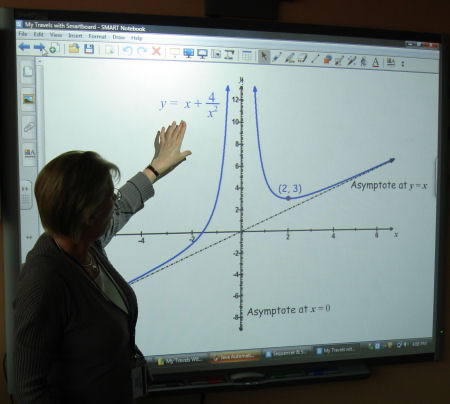
Jacky describes the asymptotes on her SMARTBoard
(b) Dynamic Visualisations
It is easy to embed dynamic visualisations into the Notebook pages. (A "Notebook" is the SMARTBoard application that allows the user to create geometric objects, and to integrate these with images and text into a lesson.)
This saves me having to jump around the room clumsily attempting to mime some dynamic mathematical concept or entreating students to imagine this or that. For example, this simple Tangent animation which I use for the introduction to differentiation was very successful. You can move the vertical slider at the right and show variable h approaching zero. The students can more easily see how the secant appraches a tangent at the limit.
A male student came up to me after that particular lesson and with visible emotion thanked me in a very heartfelt way. He was trying to find the words to say how blown away he was by having maths ideas presented in this way and how he was starting to really see what Calculus and its underpinnings of the notion of limit was all about. These moments are so rewarding.
Some (not a lot) of the Gallery items (built-in interactive and multimedia items) in the Notebook software are useful for Senior maths lessons. For example, I can get coloured dice up on the screen (as many as I like and as large as I like) and they can be rolled. Random results are generated. No more having students noisily throwing dice on the desks and having half the class on the floor under the desks looking for the dice they lose. I have used the interactive protractor a lot and the electronic timer for quick quizzes.
I can make things fade in & out, spin, fly in... fly out ..although the novelty of this has faded somewhat for both me and my students. Fade in and Fade out have been good stayers.
(c) Visually appealing
Visually, interactive whiteboards are a huge improvement over a static whiteboard. The instructor can ensure more brightness, colour, clarity, movement and pictures.
I have a giant picture of the calculator which I can bring up at the click of the mouse for example.
When we did Rates of Change, we talked about an example where a swimming pool was "being drained for cleaning purposes". Showing the students a photo of a real pool being drained meant the meaning of the question immediately becomes much clearer.
Someone has actually attempted to put the grains of rice on the chessboard to show the power of a geometric sequence and photographed the result and I show that to my students too. (For background on this, see this Fairy Story.)
Sometimes I incorporate classic art eg for a problem about maximising yield for an olive farmer I used one of Van Gogh's pictures of an olive grove.
I have Elvis Presley, one hand holding the microphone the other pointing out to his audience reminding them not to forget the "+ c" when they integrate!
I'm trying to get mathematics out of the sterile bubble students seem to put it in and into the flow of the world. So for non-English-background students and visual learners the SMARTboard has been wonderful.
(d) My lessons are better organised
My lessons are much better organised now that I am using the IWB.
Everything is there and more. I can skip pages if time is short. I can go back to previous pages again, even previous lessons from months ago at the click of a mouse or the touch of my finger. The examples are all up there.
I very rarely have my back to the class so I find that their attention is much more focussed (on me!) I have a page at the end of each lesson with the headings LANGUAGE, FORMULAE, HOMEWORK. Time is saved by having this all written out. I can be dealing with a student's question while the rest of the class is copying down that last page. I can run through the lesson privately with a student who might have been away sick or was late to class (for a legitimate reason). I can use any of the lessons for revision at any time. Students come up to the board after the lesson and scroll back to get material they might have missed. I can revise my lessons if certain things did not 'work' as I intended them and make them better and better.
(e) Enjoyment
I am enjoying using the SMARTboard so much. It really is fun!
There are some great interactive games such as:
- The classic "Switch or Stay" game
- Another game I used successfully was the "Who Wants To Be A Millionaire" Calculus game from IntMath (sound is important).
But really, the main fun for me has been the creativity that this form of teaching has pulled out from me - creativity that I hardly knew I possessed. And for a maths teacher, being creative is a bit of a novelty.
(3) What are some of the best resources that you have found to use with your IWB? How did you use them?
IWBs are an easy to use device for collecting resources which can then be inserted and used appropriately throughout a lesson - a wonderful big toolbox for the teacher and student to pick and choose from.
For Senior Mathematics, I believe that the concepts of simulation and mathematical modeling are important ideas to get across.
Just yesterday I showed my classes your Current World Population Counter because we are doing Exponential Growth & Decay. Of all the dynamic things I show these days with the Smart board, this got the most vocal response. They were rather shocked. One student said spontaneously "Oh, stop it. We have to stop it!". They asked “Is this real time? How can they get this information?” and this gave me the opportunity to talk about using an equation that models the real life situation using population data from previous years.
I have been using some really good dynamic simulations of rates of change lately such as a simulation of radioactive decay.
I have not said much about videos, probably because its been hard to find good ones.
The quadratic formula song took the students by surprise although it was a bit long
The trig video from your IntMath site was good although the ideas came thick and fast and it is best used after the topic has been taught.
Possibly the most enthralling one to watch (works well with students) is the melting ice cube Youtube video. Wonderful music (esp. after you've watched it a zillion times like I have).
A comment posted on the Net about this latter video proved to be absolutely true - "whoever would have thought that watching an ice cube melt would be so enthralling!"
(4) What have been some of the struggles that you have faced?
Getting a good looking mathematical expression or equation up there is a bit of a pain, especially fractions. They have to be constructed virtually bit by bit and then grouped as a single object. I can't use MathType which would be my wish. Having said that, with the simple toolbox provided by the Notebook software it is possible to create anything mathematical, even definite integrals and I make it a bit easier for myself by editing previous expressions that I have made or just doing a copy and paste of something I have already created, such as dy/dx.
I would like to have access to a store of good quality dynamic demos of maths concepts that I can copy and paste directly onto the pages of a Notebook file. Simple, clear animations without too much text around them (hopefully none!). Access to the internet is great but it is still not immediate enough for me.
I would like more videos created for students with non-English speaking backgrounds ie shorter videos presenting just one main idea (perhaps a real world application) where the presenter speaks slower and more simply but speaks to his/her audience as young adults not children. It would be great to then be able to embed these in an ongoing lesson.
I also struggle a bit intellectually with the knowledge that my SMARTboard lessons are very much teacher-centred. My level of control in the classroom has dramatically increased I would say and I am aware of the criticism from the teaching fraternity about this. Of course it is good for students to not just be passive recipients of education but I don't think this means running up to an IWB popping balloons and moving tangram pieces around with one finger, especially the senior students that I teach who are in the 18-20 age group.
I am also continually under time pressure to get through the content of the course and having students interact with the board (even in a meaningful way) is about 10 times more time consuming. This is something I am still thinking about.
(5) How often do you use your IWB?
I use it for every lesson. At our school we are very fortunate that about half the classrooms have an IWB set up linked to a computer on a podium. All I bring to the classroom is my 6 GB flash drive except for ONE occasion this year when I forgot it! I had to do an ordinary whiteboard lesson which was a big comedown. We are also lucky to have good IT support as the IWB software, Adobe Flash and JAVA etc need to be upgraded quite often.
(6) What software applications do you use with your IWB?
The lessons are all fully prepared in advance with examples written up but there are deliberate points at which I would actually do the solution real-time on the board. Or a student might ask a question that needs a written explanation. On these occasions I hand write. I have a small problem with the thickness of the pen. It's too thick for a complex algebraic expansion (you lose fine definition when writing say, e^(-1/x)) and I know how to make the line thinner but it won't stay thin as soon as I do something else like draw a rectangle or a set of axes. But I think this is just a matter of delving into the Help Manual.
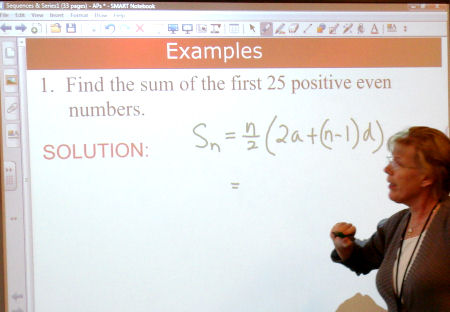
Handwriting using the digital pen.
I have found out how to get my PPT files up there and have done that earlier in the year but my preference is to convert everything to use within the Notebook application from SMARTboard. The style of PPT is different to that of an IWB, the former working like a hammer, the latter like a Swiss army knife (to use an excellent tool analogy I got from a conference recently).
I have used Excel occasionally and intend to use it more. It's more a problem of the Senior High School Maths syllabus I think, that spreadsheets do not jump out as being immediately useful. They should be! I use them so much in my everyday life I feel instinctively that they should be a much more integral part of our current maths syllabus.
I use websites quite often. Sometimes these can be slow to load up which I don't like at all as it interrupts the energy of the lesson. Lately I have been searching for Flash animations that I can just copy and paste onto a SMARTboard page. They are already moving when you open the page and I really like that. I have found two excellent ones that show a tangent moving around a concave up curve and another where the tangent moves around a concave down curve. They are simple diagrams but the tangent is moving and it is much easier then to see that the gradient is increasing, therefore rate of change of dy/dx is positive and is defined as d2y/dx2 etc.
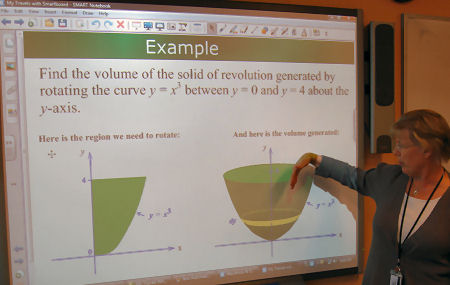
Using a lesson on volume of solid of revolution from IntMath
I spend a lot of time trawling the Net looking for mathematics applets only to be frequently disappointed by the visual presentation of many applets. They are small, faint with thin spidery font and thin, spidery animations and they would "work" too quickly!
I did find one really excellent one though which was a demonstration of the classic maximising volume problem of cutting out square corners from a sheet
If you scroll down the bottom of this page and click on Launch Presentation you get an easy to see animation (that you can control the speed of). You can even make it Full Screen. I look for more work by the same designer, Thomas S. Downey. This is the best interactive maths aid I have found this year.
(7) What do the students think of lessons presented this way?
The students have given me very positive feedback. This is the main factor that keeps me going. I surveyed them after using the SMARTboard for 6 weeks and asked them to compare lessons done this way with the old whiteboard way.
85% felt that their understanding and enjoyment of a maths lesson and their attention in class was "better" or "much better". 91% said that their interest in the Smartboard lesson was "better" or "much better" than it was for an ordinary whiteboard lesson.
I have students from other classes asking to sit in on my lessons as extra. 98% of the time I see 26 faces totally focussed on the lesson. No-one is looking bored or playing with a mobile phone or talking to their neighbour. I have had emails from students saying things like :
"I have never seen this before. I never thought you can use this kind of technology this way to teach Mathematics”
Another said:
"I'd like to say thanks a lot for your help last semester. before moving to your class, I lost my confidence but thanks to your help, I could enjoy and find confidence.I was so happy to be your student :)"
And one more:
"I want to tell you that I really enjoy your maths class, to be honest with you , I do not like maths when I was in China, however, you made me begin to got interested in learning maths."
Conclusion
Jacky concluded with the following:
The SMARTBoard has taken up huge amounts of my time this year but it has been a labour of love.
While the IWB provides lots of opportunities for enhancing lessons, it's important to remember that the teacher is still the "magic" in the classroom.
Thank you so much Jacky for your valuable contribution!
See the 13 Comments below.
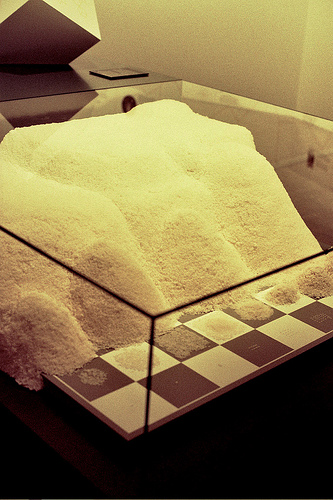

22 Sep 2009 at 9:22 am [Comment permalink]
[...] interview with a recent convert to teaching math using interactive white boards includes a lot of good ideas [...]
22 Sep 2009 at 1:26 pm [Comment permalink]
Hi Zac, I am grateful that much of what I learned from this will also work in my own less powerfully equipped classrooms (with just a computer and projector). But although I don't really want to end up feeling jealous, I would be interested to hear of any ways that either you or Jacky think the IWB is a significantly better tool for senior students. (Jacky does allude to having students interact with it themselves but also suggests that that may be less useful for those in the 18-20 age group.)Thanks, Alan.
22 Sep 2009 at 5:38 pm [Comment permalink]
Thanks for the useful resources.
However, I have a similar question to Alan's. It seems to me that while 'the teacher is still the “magic” in the classroom', if the students are just made to watch that "magic" teacher and are not that inolved, how is this technology really helping?
24 Sep 2009 at 8:10 pm [Comment permalink]
To Alan and Steve - You’ve both raised an important issue so this will be a long reply, sorry!
There are interactive elements in Smartboard that would be very appealing to junior classes eg popping balloons, and firecrackers with sound effects, a shape drawing tool, interactive ruler, interactive protractor, simple interactive games, matching exercises, ordering exercises, click and reveal activities – lots of this stuff.
With a few exceptions these are not useful for my pre-University classes.
Unfortunately, because of the word “interactive” in IWB, critics focus all their attention on whether students are physically at the board interacting with it or not and judge the IWBs accordingly. For me (at this stage in my use of the board), interactive means the way all sorts of different elements like animations, applets, videos, sound, colour, photographs, live streaming info from the internet, text animation, Word docs, spreadsheets, graphing software and so on can be organized, embedded and linked so that they interact easily with each other. And not only do they interact with each other but I am interacting with them in the designing and presenting of the lesson. So that’s where I am with the notion of interaction.
Do I believe that the IWB is s significantly better tool for senior students even though the students are just watching? Absolutely! An important Mathematics idea or concept exists like a diamond (as it always has) but the IWB has the potential to shine light on each of its facets enabling students to approach the work from different viewpoints each according to what suits their learning style best. For example, today I was teaching compound interest. The class and I worked out a few amounts manually, then I clicked on an embedded spreadsheet, entered the beginning cells and filled down to 25 years, then did a simple line graph in Excel, class agree that the graph looks exponential, fill down to 50 years, add extra values into graph and it really looks dramatically exponential now and note the rate of increase! (draw tangents on graph). Compounding sure is powerful growth. This whole procedure would not have taken more than 5 minutes. Class very engaged and interested. I could never have done this with an ordinary board and not nearly as quickly and seamlessly with a computer and a projector.
26 Sep 2009 at 11:51 am [Comment permalink]
Thanks for your reply, Jacky.
Have your students seen this article? What are their comments about this issue?
Here's an important issue - if the IWB has re-energised someone's love and interest in teaching, doesn't that mean they have value?
27 Sep 2009 at 2:47 am [Comment permalink]
Hi Jacky,
I think you have addressed your reply more to Steve's question than to mine. I was not questioning the merit of what you do, but just the need for an IWB to support it.
I can see the possible value of having students "popping balloons" etc for those that do use those features, but I still wonder which aspects of what you do with senior students could not be done just as well with a substantially cheaper setup. I have a tablet PC and projector in many of my own classrooms, and can do all of the things that you described. Perhaps I don't do it quite as well, but the deficiency is mostly in my own imagination, slightly perhaps in software integration, and very little in the fact thet the IWB is its own input device. My question was how the IWB is a better tool than PC and projector for those kinds of presentations.
Thanks again for all your good ideas.
Alan
3 Oct 2009 at 8:58 pm [Comment permalink]
I love my IWB and use it every day!
There is a list of IWB Resources on my blog. The calculators and tools also work well on the IWB.
3 Oct 2009 at 9:06 pm [Comment permalink]
Thanks for the great list of resources, Colleen.
Have you checked out any of the math applets on IntMath? Maybe there is something useful there for you.
3 Oct 2009 at 9:14 pm [Comment permalink]
Excellent Zac - thank you.
I have added this to the list. (I do like Diigo - a great way to save bookmarks.)
1 Aug 2010 at 2:20 pm [Comment permalink]
Great article and a resource to me. Sure I will use this to convince my senior class teacher Trainees, in Maldives.
We are just introducing this,IWB, great resource into our schools.
26 Feb 2015 at 11:01 pm [Comment permalink]
I've heard of these before. My university is playing around with the idea of introducing them to class. I'm interested in it. I think it could be a very beneficial thing.
19 Jun 2015 at 3:54 pm [Comment permalink]
Even though it takes much time to learn how to use smart board, the out put is awesome. It may be costly but let's uphold and embrace this change in presentation.
29 Sep 2018 at 10:03 pm [Comment permalink]
If you need a simple, still powerful online whiteboard with realtime collaboration, I recommend Ziteboard (https://ziteboard.com) It has a great feature, the graph plotter synced in real time.